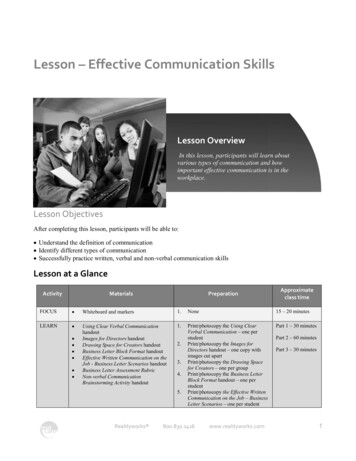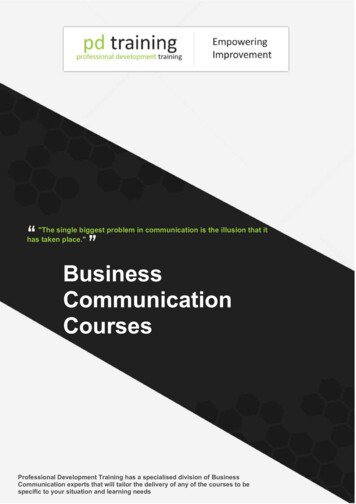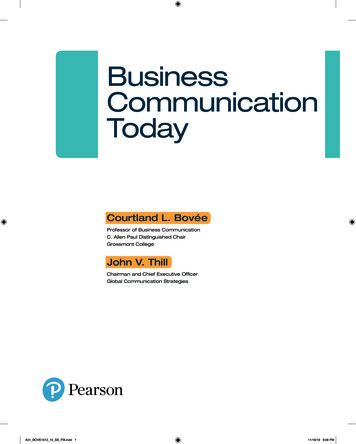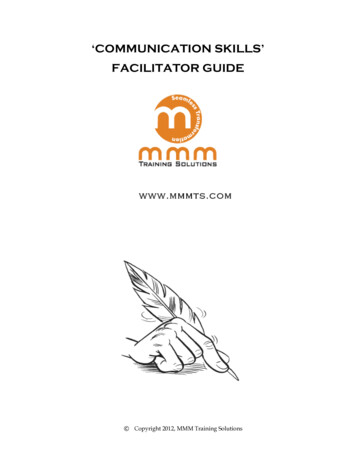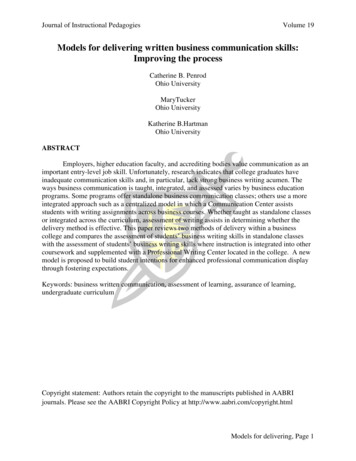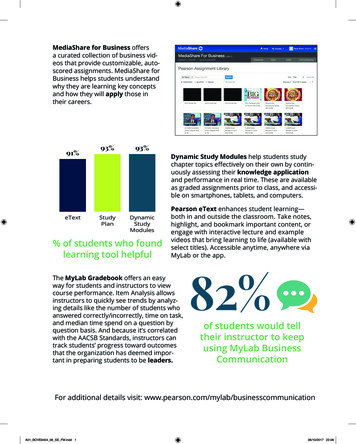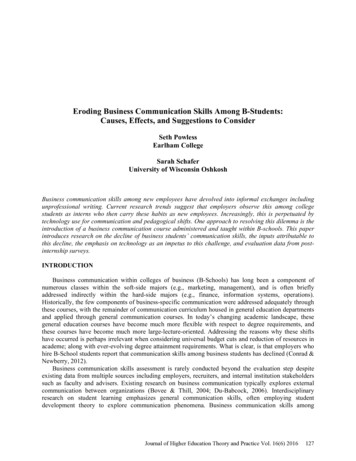
Transcription
Eroding Business Communication Skills Among B-Students:Causes, Effects, and Suggestions to ConsiderSeth PowlessEarlham CollegeSarah SchaferUniversity of Wisconsin OshkoshBusiness communication skills among new employees have devolved into informal exchanges includingunprofessional writing. Current research trends suggest that employers observe this among collegestudents as interns who then carry these habits as new employees. Increasingly, this is perpetuated bytechnology use for communication and pedagogical shifts. One approach to resolving this dilemma is theintroduction of a business communication course administered and taught within B-schools. This paperintroduces research on the decline of business students’ communication skills, the inputs attributable tothis decline, the emphasis on technology as an impetus to this challenge, and evaluation data from postinternship surveys.INTRODUCTIONBusiness communication within colleges of business (B-Schools) has long been a component ofnumerous classes within the soft-side majors (e.g., marketing, management), and is often brieflyaddressed indirectly within the hard-side majors (e.g., finance, information systems, operations).Historically, the few components of business-specific communication were addressed adequately throughthese courses, with the remainder of communication curriculum housed in general education departmentsand applied through general communication courses. In today’s changing academic landscape, thesegeneral education courses have become much more flexible with respect to degree requirements, andthese courses have become much more large-lecture-oriented. Addressing the reasons why these shiftshave occurred is perhaps irrelevant when considering universal budget cuts and reduction of resources inacademe; along with ever-evolving degree attainment requirements. What is clear, is that employers whohire B-School students report that communication skills among business students has declined (Conrad &Newberry, 2012).Business communication skills assessment is rarely conducted beyond the evaluation step despiteexisting data from multiple sources including employers, recruiters, and internal institution stakeholderssuch as faculty and advisers. Existing research on business communication typically explores externalcommunication between organizations (Bovee & Thill, 2004; Du-Babcock, 2006). Interdisciplinaryresearch on student learning emphasizes general communication skills, often employing studentdevelopment theory to explore communication phenomena. Business communication skills amongJournal of Higher Education Theory and Practice Vol. 16(6) 2016127
business students is a subset of communication and worthy of academic inquiry because of this uniqueintegration and evolution with technology.The variables associated with why business communication skills among business students arefoundering include technology evolution within communication, dependency on technology forcommunication, and fewer opportunities to practice presentation and interviewing skills due to largerclass sizes in the communication areas. Examining these variables along with the shifts in businessstudents’ comprehension of business communication is an integral area of focus for research in business.Business students continue to evolve as a population, due to shifting populations, the changing highereducation landscape, and changing emphases within business disciplines (Lesikar, Flatley, & Rentz,2008). Business majors that were once rather broad in scope are now being fine-tuned to reflect themodern business environment’s needs and as a result, general business acumen courses are often renderedcursory at best. One of the pivotal skillsets that continues to wane is the area of business communication.This paper attempts to introduce and justify such a remedy for this growing challenge all businesses mustaddress.LITERATURE REVIEWDefining Business CommunicationBusiness communication can be defined as “the use, adaptation, and creation of languages, symbols,and signs to conduct activities that satisfy human needs and wants by providing goods and services forprivate profit” (Reinsch, 1996). Business communication is the process of sending and receiving verbaland non-verbal messages within the organizational context. It is a procedure of generating, transmitting,receiving, and interpreting messages in interpersonal, group, public, and mass communication context viawritten and oral formats (Conrad & Newberry, 2011; Conrad & Newberry, 2012), such as writing andspeaking competencies, interpersonal/collaborative competencies, international communicationcompetencies, and technology competencies (Bennington, 2004; English, Manton, & Walker, 2007).The most common constructs of business communication utilized include reading, writing, oralpresentations, and listening. This foundation is derived from the historical core skills required to beconsidered an educated person (Conrad & Newberry, 2011). However, it appears that these skills aloneare deficient to satisfy business employers’ needs. Conrad & Newberry (2011&2012) revealed that theskills businesses most sought from their employees should be defined by communication behavioroutcomes; for instance, the ability to negotiate a solution between two conflicting parties. Eventually,they developed three skills sets based on the widely accepted communication constructs of organizational,leadership, and interpersonal communication.Organizational communication skills refer to those skills an organization uses to efficientlycommunicate with all internal and external stakeholders, permitting collaboration among people andorganized behavior, such as resolving conflict, negotiating, and using information technology. Leadershipcommunication skills refer to those skills which allow business leadership to effectively communicatewith internal employees and key external constituents employing communication methods includingstories, informality, metaphors, and strategic dialogue to create trusting and supportive relationshipsamong colleagues and employees. Interpersonal communication skills are those skills that allow bothemployees and employers to effectively communicate to internal and external constituents on a personal,intimate, and one-on-one basis, by exchanging thoughts in face-to-face verbal and nonverbal contexts.This is achieved by sharing information, providing feedback, or to simply maintain a social relationship,such as active listening and building rapport (Conrad & Newberry, 2011; Conrad & Newberry, 2012).Importance of Business CommunicationCommunication skills, written and oral, formal or informal, are crucial for employee and businesssuccess. Business communication abilities are critical to employees’/students’ career success and animportant contributor to organizational success. Prior studies indicated prominent agreement regardingthe importance of student/employee communication skills to achieve successful job performance (Conrad128Journal of Higher Education Theory and Practice Vol. 16(6) 2016
& Newberry, 2011; Conrad & Newberry, 2012; English, Manton, & Walker, 2007). Communicationskills are ranked among the most important skills for business students to possess (Bennington, 2004).For organizations, communication is seen as an integral part of every organizational activity andcannot be seen as an isolated part. Effective business communication is the pivotal issue to planning,leading, organizing, and controlling the organizational resources to achieve business objectives (Conrad& Newberry, 2011; Conrad & Newberry, 2012). Studies suggested that students with excellentcommunication skills will likely provide more value and more professional image to their employers andprojects than those whose communication skills are considered poor (Lentz, 2013).To see the importance of each set of communication skills, organizational communication skills willenhance the organizations’ ability to store information, train employees, and maintain order within theorganization; leadership communication skills will drive effective leadership including the ability tocommunicate openly, use a persuasive approach, and graphically describe a picture of the future;interpersonal communication skills will help all organizational members to manage emotions and controlreactions to stressful situation factors (Conrad & Newberry, 2012).Business Communication TrendsThe historical roots of business communication can be located in the intertwined history of businesspractice, vocational training, human sciences such as grammar and rhetoric, and the evolution of highereducation (Reinsch, 1996). Therefore, business communication used to be a study of rhetoric in thewriting of letters and memos, beginning with emphasizing the proper forms and correct use of English(Du-Babcock, 2006). Not only does technology change business practices, but also it changes thebusiness communication field (Reinsch & Turner, 2006). With the emergence of cellphones and voiceconference, the emphasis of business communication was trending toward oral skills during the 1980s.However, written business communication is again becoming the highest priority due to changingtechnology uses of telephone and face-to-face communications to electronic text communication(Bennington, 2004).In the past, the communication environment was relatively homogeneous and stable, general languagecould be adequately used in encoding and decoding messages (Du-Babcock, 2006). Consequently, presentbusiness communication is in a transitional stage due to a more complex and globalized businessenvironment and the multidisciplinary communication teaching environment. In this stage, the underlyingcommunication process remains constant, but individuals are communicating via more variablecommunication media, such as cell phones, videoconferences, emails, memos, and face-to-face meetings.Therefore, the challenge for current instructors is to teach students how to communicate in theincreasingly diverse and complex global, multidisciplinary communication environment (Du-Babcock,2006).Technology Use Among B-StudentsThe new communication identified as technology mediums (e.g., cell phones, tablets) allow people tocommunicate and collaborate more effectively and efficiently. New technologies offer newcommunication channels for organizational members, eliminate geographical barriers in communication,increase the volume of message exchange, enhance a worker’s efficiency, and decrease the transactioncosts of exchanging messages (Decarie, 2010; Du-Babcock, 2006; Meredith, 2012; Reinsch & Turner,2006).Conversely, the impacts of technology on business communication are conflicted, particularlyinvolving student use. Students often prefer to utilize impersonal, non-verbal forms of communicationand current technology allows for that. What’s more, social support for technology mediums ofcommunication increases this paradigm which further contributes to a growing deficiency in personalcommunication skills including speaking to others, writing professionally, and presenting (Massimini &Peterson, 2009).A critical example of this is the use of Facebook as a means of communication. Facebook hasemerged as the dominant social networking site with more than 600 million active users including bothJournal of Higher Education Theory and Practice Vol. 16(6) 2016129
individuals and industries or businesses alike. Facebook has several benefits. It serves as an interpersonalcommunication outlet, allows for greater personalization, and promotes cross-cultural communication byeliminating geographical barriers (Decarie, 2010; Ellison, Steinfield, & Lampe, 2007). However, severalchallenges continue to plague Facebook use as a means of communication. Maintaining professionalismis a growing challenge for users, writing skills are devolving to a more informal level due to the use ofFacebook or similar platforms for extended periods of time, and combined, these challenges foster overalllower communication skill thresholds (Decarie, 2010).Current technologies are not only influencing the way businesses communicate globally, but alsoimpacting the way instructors teach, students learn, and scholars conduct research (Du-Babcock, 2006).Students use technology to complement and extend their classroom experience. However, the use ofinformal writing can spill over to influence potential/current employers who also engage in technologymediums for communication. Similarly, business contacts and future colleagues may be affected byobserving weak communication skills by students on technology mediums. As a result, it is becomingcritical that business communication not only be included in B-school curricula, but that technology havea place in this area of study (Decarie, 2010). On a similar note, researchers have increased theirtechnology use as a research medium to exchange research ideas and in some instances, technology itselfbecomes the vehicle for research (Bennington, 2004). Finally, at the instructional level, instructors havecommenced engaging students through the use of technology. Technological competency has become acritical component of all B-school curricula regardless of major, and side benefits include furtherdevelopment of critical thinking and writing abilities (Bennington, 2004).DEFICIENT BUSINESS COMMUNICATION SKILLSIn recent years, scholars found that students’ discipline-specific skills are no longer the priorityemphasized by employers (Conrad & Newberry, 2001). Conversely, students’ communication skills havebecome a critical skillset that ranks as highly important including general communication skills,technological literacy, and teamwork (Bennington, 2004). In spite of this support, at the micro-levelorganizations overlook business communications functions and skills including online communication,media relation, community relation, employee internal and external communication, marketing,product/brand communication, and advertising (Conrad & Newberry, 2011).Despite the agreement in business regarding the significance of communication skills, a gap persistsbetween desired and acquired communication skills (Conrad & Newberry, 2011; Conrad & Newberry,2012; Lentz, 2013; Lanier, Tanner, Zhu, & Heady, 1997). Evidence exists that both long-term employeesand entry-level employees still lack communication skills: writing, speaking, grammar, and vocabularychoices (Bennington, 2004; Lentz, 2013; Lanier, Tanner, Zhu, & Heady, 1997). Most employers believestudents are deficient in verbal and non-verbal skills since they may not receive adequate education inthese skills within their business coursework (Conrad & Newberry, 2011).Conrad & Newberry (2011) revealed that a significant ratio of firms reported one third or fewer oftheir employees, both current and new, failed to see the value of writing skills. Consequently, firms spend 3.1 billion on affording training in writing annually. This study also demonstrated the unsatisfactory oralcommunication skills of recent graduates, though oral communication has been viewed as one of the topthree competencies required to succeed in a managerial position (Conrad & Newberry, 2011).Employers’ Perceptions VS Educators’ PerceptionsDespite the agreement of the importance of business communication between academia and realworld business, employers generally disagree on the order of importance of communication skills. Onepossible explanation of this inconsistency may be academics’ emphasis on theories and models whileemployers’ emphasis on skills and abilities that produce applied outcomes (Conrad & Newberry, 2011).A few scholars found that skills taught in some business communication courses appropriatelymirrored those deemed important in real business settings (Bennington, 2004). However, there are stillsome skills, such as using information technology, writing business correspondence, and creating team or130Journal of Higher Education Theory and Practice Vol. 16(6) 2016
group synergy, that are drawing more attention from employers than business educators (Conrad &Newberry, 2011).In addition, further studies suggest that business professors feel they already efficiently assess theirstudents’ readiness for future employment, but the reality is that professors often are not readily aware ofhow well their students will communicate versus what employers expect; often employers assess andreport communication skills of interns and new employees at the conclusion of an experience such as aninternship or work assignment. This information is often anecdotal, reported to administrators only, and isnot uniform. (Conrad & Newberry, 2011). Therefore, researchers emphasized the necessity for ongoingassessment of business communication commencing with a business or workplace communicationemphasis within the curriculum itself (Bennington, 2004; Conrad & Newberry, 2011; Conrad &Newberry, 2012).Students’ PerceptionMost students evaluate their writing as direct, logical, organized, clear, and adapted to the audience,while few students identified grammar and spelling as weaknesses (Lentz, 2013). Students did notidentify competencies as a primary cause of poor writing in the workplace, instead, students stated thatlack of clarity and time limitation is the primary driver of poor workplace writing (Lentz, 2013). Inregards to verbal communication, most students are not aware that informal verbal communication is notan accepted norm within most organizations (Lentz, 2013).Students’ perception shows that they perceive no direct reward for writing or speaking professionallyin the workplace. Other students reflected that while professional writing played a role in resolving acustomer dispute, the resolution, not the communication, was what was rewarded (Lentz, 2013). Studentsbelieve their companies do not value strong professional writing and speaking and do not provide anyaccountability for this. In this point of view, the weakness in an organization’s communication culture isanother cause of poor writing and speaking. Students demonstrated that the other reason for a lack ofcommunication professionalism is time restraints. They implied that if they had time, they would writeand speak more professionally or at least attempt to develop these skills (Lentz, 2013).Evidence of DeclineIn response to initial research indicating business communication is in decline (Watkins, 2014),existing data compiled in a 2009-2014 ongoing employer survey conducted at a large, MidwesternUniversity college of business was assessed. Over 250 unique employers pointed out the areas studentsneed to improve in terms of communication skills. The survey and in-process report was sent out viaemail to all employers who either employed a business student as an intern or a new employee gaugingtheir satisfaction with these individuals. Employers were concentrated in Ohio, Michigan, and Indiana. Ofthe 250 employers surveyed, response rate was nearly 90%. Three specific questions addresscommunication skills of the intern/new associate. According to the report, more than half of the studentscannot articulate themselves professionally, and 24% of employers think their intern’s need to work onimproved non-verbal communication skills. Additionally, 18% of recruiters assert that students are notwell-prepared for the internship. Another major area needing to be improved is gaining relevantexperience. Employers state that students fail to see the value in gaining relevant experience, and with noexperience, there is no study to tell.The employers’ responses regarding the rating of intern’s communication skills indicate that theyview students exhibited strong communication skills, both verbal and written. On a scale of 1 to 4, with 4being “outstanding” and 1 being “below standards”, 72 of 250(29%) employers view their interns haveoutstanding oral and written communication skills. And 35% of recruiters think the students’communication skills, both oral and written skills, are above the standards. Additionally, 32% and 9% ofemployers respectively think students’ communication skills are at “just meet standards” and “belowstandards.”Following the question of rating intern’s communication skills, employers and recruiters are asked thequestion “does student exhibit strong communication skills, both verbal and written?” On a scale of 1 toJournal of Higher Education Theory and Practice Vol. 16(6) 2016131
4, with 1 being “strongly disagree” and 4 being “strongly agree”, 42% of employers strongly agree thatstudents have strong verbal and written communication skills, and 18% disagree. However, compared tothe 2011-2012 analysis, 49% employer strongly agree that students get proper communication skills and14% disagree. Therefore, there is clearly evidence showing that the business communications skills ofstudents are declining.B-SCHOOL CURRICULUM CHANGESBusiness communication skills are identified as one of the key issues in the course of marketing,accounting, public relations, corporate communication, and leadership communication courses. Forinstance, as accounting has evolved from a bookkeeping, number-calculating activity to an analysis,reporting, and advising profession, the accounting profession has taken a special interest incommunication skills. However, the deficiencies of communication skills in new accountants call for amore comprehensive approach in accounting programs. Similar situation also exist in information systemand public relations programs (Conrad & Newberry, 2011).As business communication is becoming more significant in many fields, a more cross-disciplinaryuniformity is called for in contemporary business communication education (Conrad & Newberry, 2011).Business communication instructors should collaborate with other business faculties to determine whichbusiness communication competencies should receive the most emphasis.Resolution: B-School Business Communication CurriculaBusiness communication courses should be designed to teach written and oral communication skillswith an emphasis on business-related content and foci including technology (Bennington, 2004). Aspecific business communication course offered to all business students taught by business faculty willhelp students develop written and oral communication skills which will assist in their career paths.Business communication textbooks generally agree on the topics to be covered in the businesscommunication course: importance of business communication, business writing process, executivesummary writing, e-mail and brief message writing, oral and online presentations, technologies used inbusiness communication, job interviewing, and team collaboration (Lesikar, Flatley, & Rentz, 2008;Bovee & Thill, 2004).Business communication courses need to be updated and revised accordingly; this especially appliesto demographics of specific cohorts such as non-traditional students, classes comprised of students all inone major, and courses offered off-site (Reinsch & Turner, 2006). In addition, new teaching approachesshould be used in teaching process while continuing to stress the fundamentals of effective businesscommunication (Du-Babcock, 2006). In order to make sure students are capable of applying businesscommunication skills in the future, associated application materials should be added in the businesscommunication courses in addition to business communication theory and models (Conrad & Newberry,2011). It is the responsibility of communication instructors to show students the applied contemporaryvalue of mastering persuasive writing strategies including proper business grammar (Decarie, 2010).Business and Workplace CommunicationIn response to the decline of business communication skills, a business communication course hasbeen set up at a large, Midwestern University in Ohio. This skills-based communication course equipsstudents to effectively make oral presentations individually and in teams, while practicing writing concisesummary reports, adopting the acceptable business conventions for correspondence, email, and voicemail. In order to learn and practice techniques for managing and reducing speech anxiety, makingengaging oral presentations individually and in group situations, using visual aids correctly, and writingemail, memos, reports, thank you notes, etc. without error, six modules were set up. The six modulesdescriptions are provided below:132Journal of Higher Education Theory and Practice Vol. 16(6) 2016
(1) Overcoming Stage Fright and Performance Anxiety- This is the first assignment in anassignment sequence. Students will learn how to become an engaging communicator byaudience interaction. Managing and controlling performance anxiety and stage fright arealso addressed.(2) Networking and Interpersonal Skills- a DiSC personality profile is completed in thismodule to help students understand themselves and their audience. The ability to knowtheir own communication style and how others prefer to be communicated with would beenhanced by this activity. Students will learn how to connect with others using email andother written correspondence, as well as making sure to avoid embarrassing themselves.Additionally, students will learn the “art” of personal introduction and networking in thismodule.(3) Planning and Organizing Presentations- Forms and structure of presentation areintroduced to students. Students learn to package and deliver their message by using“Nichols Two Things”. Finally, students learn how to plan a specific type of meeting andhow to keep a meeting on track during this module.(4) Techniques for Creating Engaging Presentations- Students learn how to draw uponthe senses and use vivid and descriptive language to help bring listeners into thepresentation. Students learn to be confident and engaging, speaking with dynamicopenings and closings. Furthermore, they learn how to tell a story that engages theaudience and illustrates the point they wish to make, by using “PIP”: Premise,Illustration, and Point.(5) Presenting Data and Information- some of the worst oral and written presentationsoverwhelm or confuse the audience with the data. Students learn how to use data so thatit enhances their presentation or report. Additionally, students learn how to usepresentation slides to enhance, rather than detract, their presentation. The second part ofthis module is dealing with information. In this lesson, students learn how to succinctlycapture the ideas, suggestions, conclusions, and recommendations in summary sentenceswithout spelling, grammar, and punctuation errors.(6) Persuasive communication- In this session, students learn the stages of persuasionprocesses and how it applies to different persuasive situations. Additionally, studentslearn the basic format and process of how to write a persuasive memo. An individualpersuasive presentation is required from students.OTHER SUGGESTIONSAssess Business Communication EffectivelyFor the purpose of staying up-to-date and responding efficiently to the needs of our students,standardized skill assessments should be sensitive to, and adopted from, real business communities(Bennington, 2004; Conrad & Newberry, 2011). Employers’ perceptions of employees’ businesscommunication competencies can assist in assessing learning outcomes of business communicationcourses. Thus, the bridge of understanding between business and academia must be constructed forassessing and addressing the communication skills business employees need.Business and industry professionals should be included in the curricula process and be able to expressthe specific communication skills they require. Organizations should develop a communication strategyfor the overall organization (Conrad & Newberry, 2011). In addition to demonstrating guidelines forcurricula, communication strategies also promotes positive public image and a strong, transparentcommunication culture (Lentz, 2013). At the same time, educators must explore and understand theJournal of Higher Education Theory and Practice Vol. 16(6) 2016133
specific communication skills real businesses need (Conrad & Newberry, 2011; Du-Babcock, 2006).Therefore, instructors can keep business communication teaching relevant and related to the everchanging and evolving global environment.Using Technology IntelligentlyBefore deciding to adopt communication technologies for classroom use, either as a measure ofinstruction or as components of learning activities, business communication instructors need to considerthree foundational questions routinely.First, does the emphasis on social media technologies in the classroom match the use of thesetechnologies in the workplace? As a means of Web 1.0, email still dominates other communicationchannels in the workplace today, and is expected to be the primary business communication tool for atleast the next 5 years (Cardon & Okoro, 2010). Researchers and consultants also predict that socialnetworking will replace email and become the main communication tool in the future in about 20% ofcompanies (Cardon & Okoro, 2010). From this point of view, instructors should introduce these emergingcommunication technologies such as blogs, wikis, and social networking sites; however, the importanceof some Web 1.0 technologies such as email cannot be ignored.The second question should be whether the technologies instructors adopt in the classroom are bestclassified as tools for business communication across all majors (Cardon & Okoro, 2010). For example,Facebook and Twitter are widely used marketing tools; while blogs are successful leadershipcommunication tools.The last question should address whether the use of social media in the classroom complements andsupports traditional face-to-face communication (Cardon & Okoro, 2010). To sufficiently preparestudents for the workplace, the utilization of social media in the classroom should complement
The variables associated with why business communication skills among business students are foundering include technology evolution within communication, dependency on technology for communication, and fewer opportunities to practice presentation and interviewing skills due to larger
